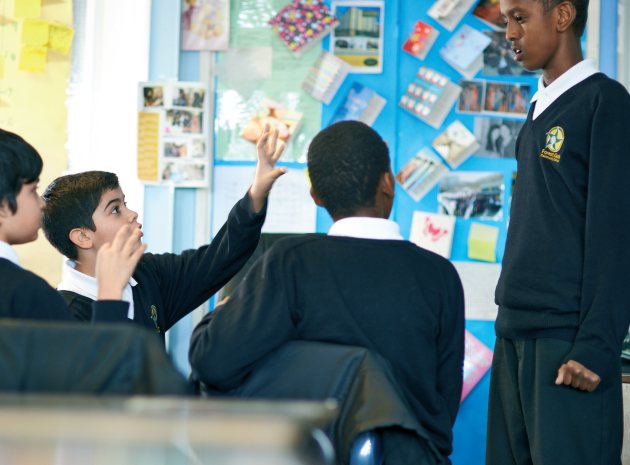With the General Election nearly upon us, now is the perfect time to get your students perfecting their persuasive powers, says Stu Fink…
We’ve all met those students you can hear minutes before they turn the corner of the corridor. Often, the one sure way of silencing them is inviting them to talk to the class. Whether in a small group or in front of everyone, expressing ideas can be daunting to students. Speaking to others is absolutely crucial out in the real world though.
With the General Election round the corner, now could be a good time to show just how important speaking skills are to your students. The ideas below are meant to get everyone chatting away in class so that all students have the opportunity to speak. Splitting the class into groups is a good way of ensuring everyone - from the shrinking violet to the motor-mouth - has a chance to speak and, importantly, to listen
Why teach this?
From politics to production, science to sales, technology to – yes – teaching, great oratory is the key to success. Students who can engage with others, who can engage others, and who can debate brilliantly will be at a massive advantage as they make their way into the world.
At the start of the lesson, display this line on the board at the front of the class: ‘We do not have to accept the world as we find it’.
Give students five minutes to think about how this line should be delivered as a line in a speech, discussing in their groups. Depending on the class size, perhaps individuals can deliver the line, while other students critique this.
Repeat the activity with the lines: ‘I am a passionate believer in free speech’ and ‘We will do everything we can to help you’.
In addition to discussing how these lines should be delivered, get students to think about how the audience is likely to react to these lines and why these words have been chosen. The use of pronouns is striking.
Next, ask students to guess who said them – Ed Miliband, Nick Clegg or David Cameron. Again, you might decide to have a brief discussion about this. You can remind students that there is about to be a General Election, where these politicians will have to convince the public to vote for them.
Key Question: Why is it important for politicians to be able to communicate well?
Students can now discuss and make notes about this key question. Follow up questions might include: To whom do they speak? What kind of speaking do they do? What does it mean to speak ‘well’?
This starter activity should take approximately 10 minutes.
1. Start talking
As one of the main lesson activities, try giving groups of students a series of controversial statements, designed to get them debating. I’ve had success with silly statements like ‘girls are better than boys’. With this kind of thing, you can experiment with who should argue which position. It might be necessary to label students A and B, for example, so that there will be an equal split in each mini-debate. Other statements could be ‘Students should be paid for coming to school’, ‘It is important to be rich’, and ‘Young people spend too much time on their phones’. I find that topics that students can easily identify with spark off better debates.
After each mini-topic, you can discuss with them what went well – did someone say something interesting, who was able to listen well, were students responding directly to what was said. Depending on what you think would work best for your class, you can move students around after each debate, have showcase debates if some students are demonstrating excellent debating skills, or group less confident children together to ensure they can contribute.
Taking things forward: Think about setting the students a research based homework. Half will prepare to argue in favour of a position, the other half will argue against. This might lead to extended small-group debates, a whole-class debate, and perhaps the speech can be assessed as a piece of writing too. More able students may be asked to prepare for both sides of the argument, and be switched periodically during the debates. They could even chair debates, ensuring everyone contributes and helping to stimulate discussion.
2. Sealed and delivered
For the second main activity, work on students’ presentational skills. Students can work on preparing a very short speech on a given subject. It needn’t be any longer than fifteen seconds. Give students a few minutes for this – it might be a good idea to suggest some helpful presentational tips. For some groups, a very short pre-prepared speech can be supplied. With the whole class, discuss what makes a good speech. Something I’ve enjoyed doing is getting students to try talking to a classmate about something really exciting that they have done with as little animation as possible, then discussing something boring, perhaps a wet Monday morning in November, with as much enthusiasm as they can muster. Now students can pair up and practise their short speeches. Get students to deliver their short speeches one at a time at the end of the lesson. After each speech, ask the rest of the class to identify something their classmate has done well, whether it was a gesture, the tone of their voice etc. and suggest something they could improve on.
Home learning
Ask students to prepare a longer speech to deliver in front of the class. You can differentiate by length of speech, topic and success criteria: for some students, getting up and speaking is in itself a massive achievement. My students responded enthusiastically to the task ‘Vote for me as President of the World’ – there’s so much that they can cover, from big issues to small things that annoy them!
About our expert
Stu Fink is in his third year of teaching English, having joined All Saints Catholic School in Barking and Dagenham at the start of the academic year.










